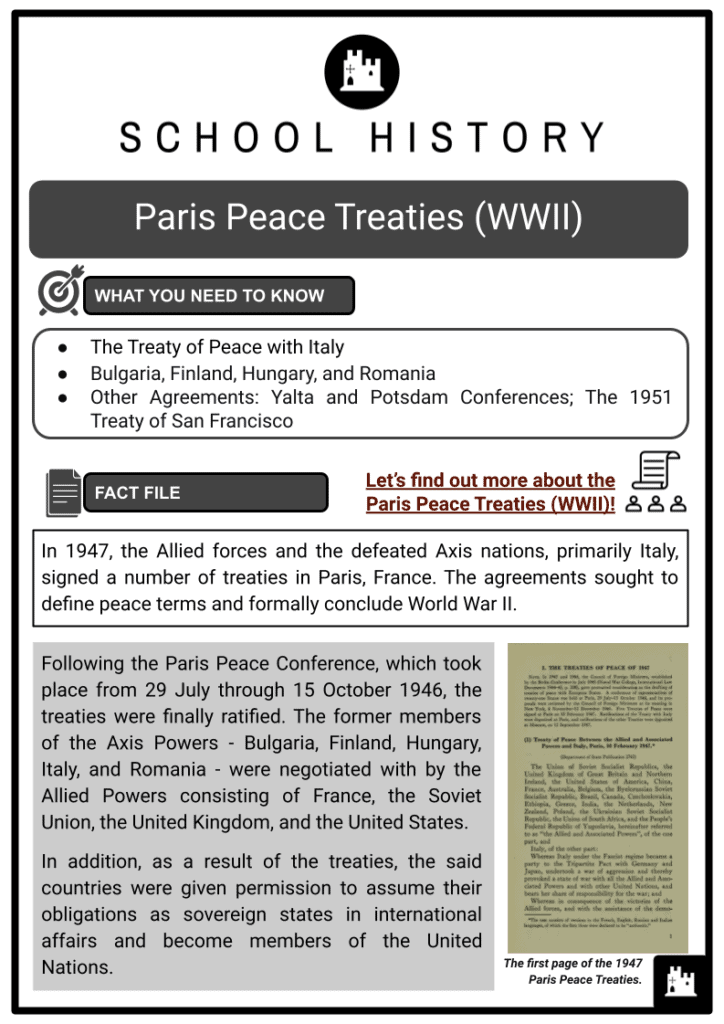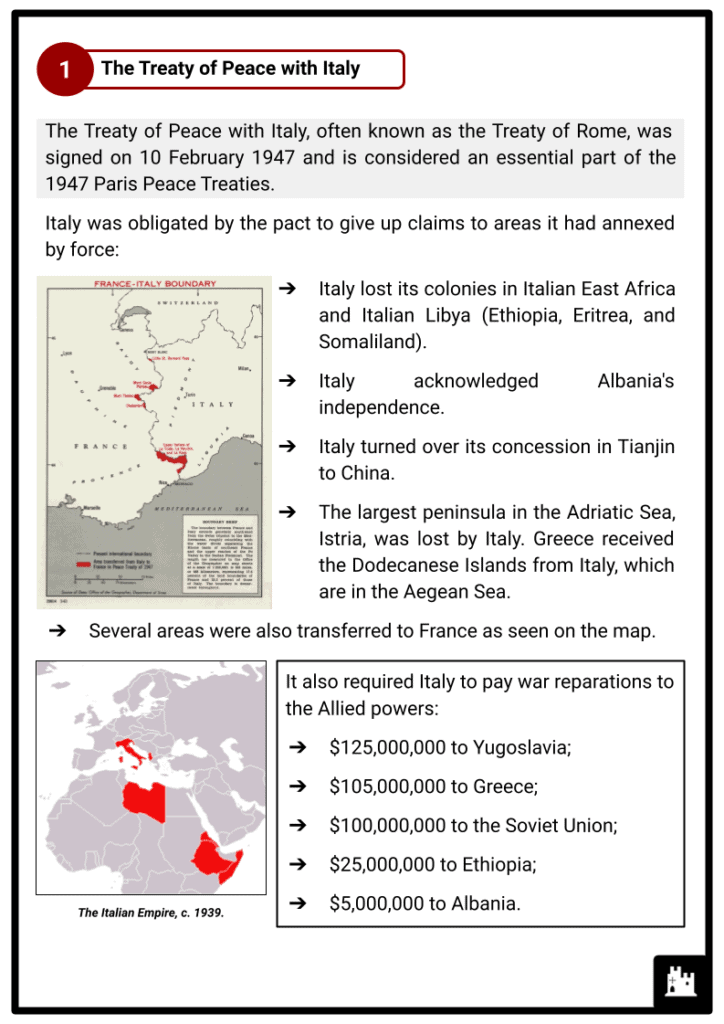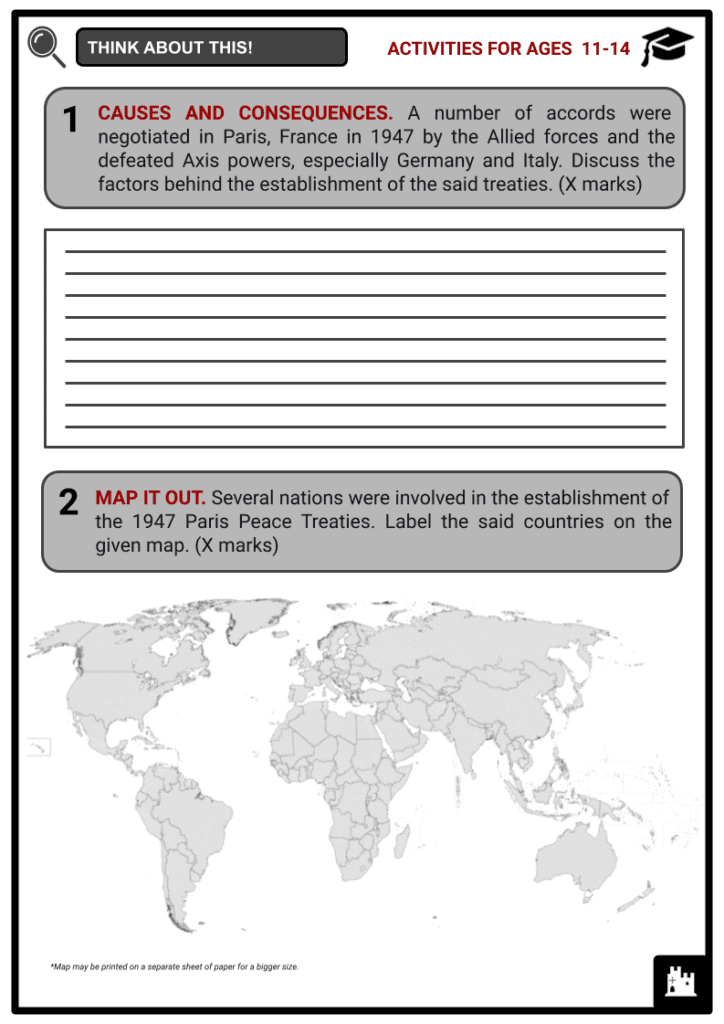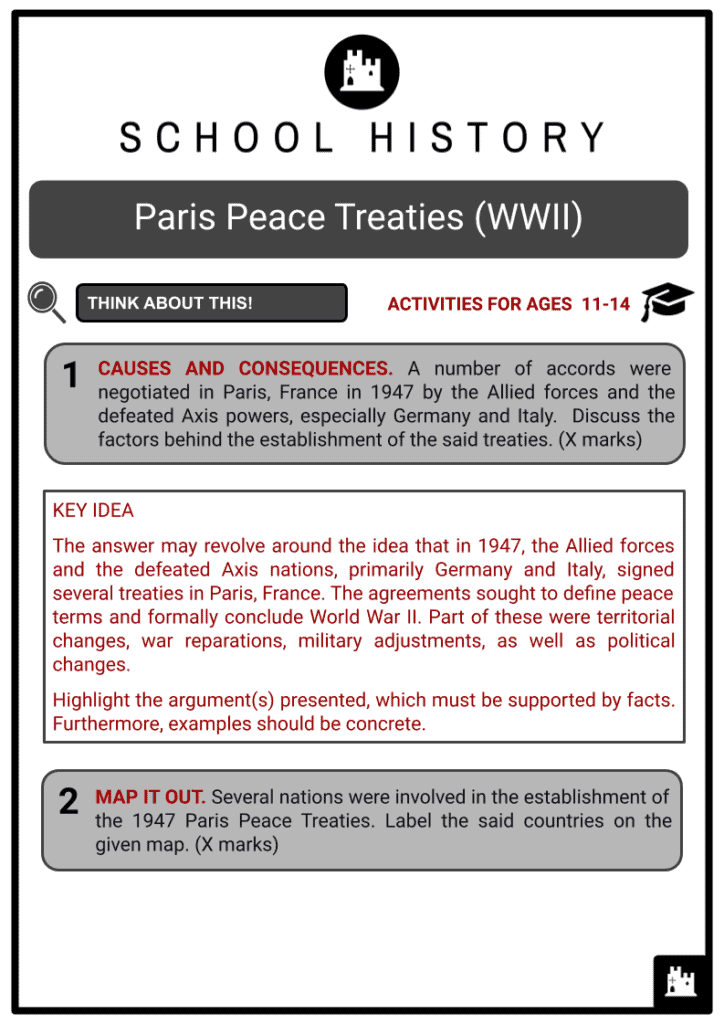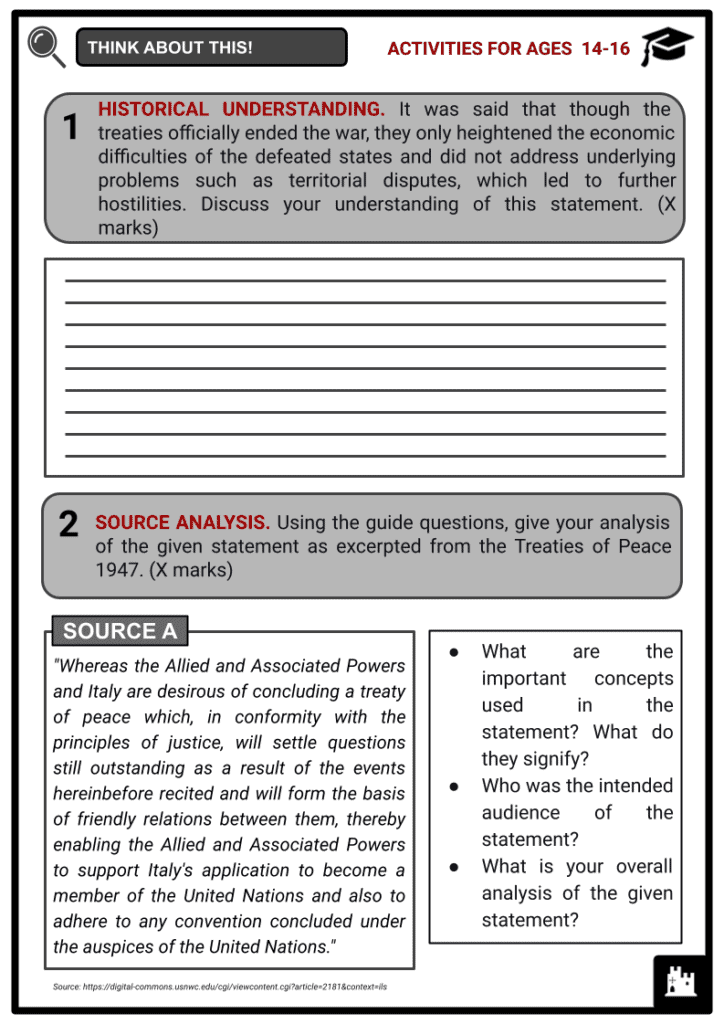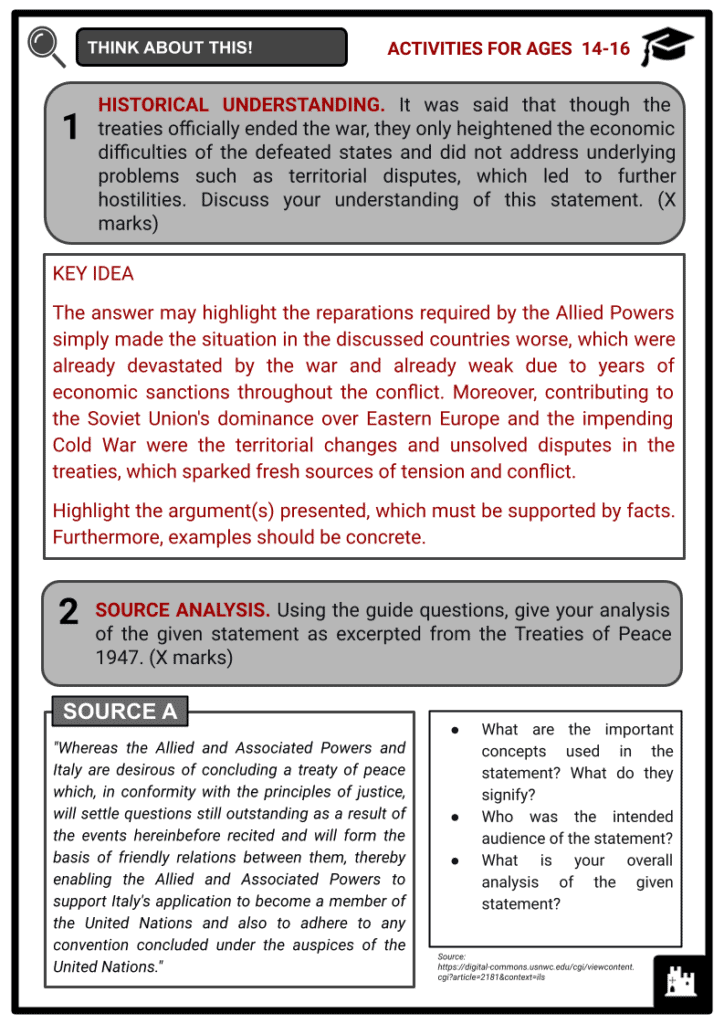Paris Peace Treaties (WWII) Worksheets
Do you want to save dozens of hours in time? Get your evenings and weekends back? Be able to teach about the Paris Peace Treaties (WWII) to your students?
Our worksheet bundle includes a fact file and printable worksheets and student activities. Perfect for both the classroom and homeschooling!
Summary
- The Treaty of Peace with Italy
- Bulgaria, Finland, Hungary, and Romania
- Other Agreements: Yalta and Potsdam Conferences; The 1951 Treaty of San Francisco
Key Facts And Information
Let’s find out more about the Paris Peace Treaties (WWII)!
In 1947, the Allied forces and the defeated Axis nations, primarily Italy, signed a number of treaties in Paris, France. The agreements sought to define peace terms and formally conclude World War II.
Following the Paris Peace Conference, which took place from 29 July through 15 October 1946, the treaties were finally ratified. The former members of the Axis Powers - Bulgaria, Finland, Hungary, Italy, and Romania - were negotiated with by the Allied Powers consisting of France, the Soviet Union, the United Kingdom, and the United States.
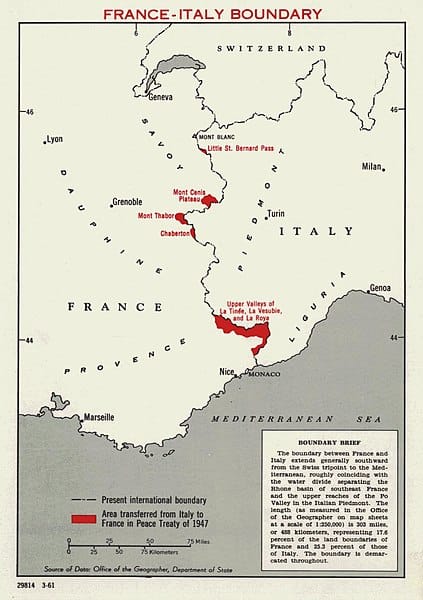
In addition, as a result of the treaties, the said countries were given permission to assume their obligations as sovereign states in international affairs and become members of the United Nations.
The Treaty of Peace with Italy
- The Treaty of Peace with Italy, often known as the Treaty of Rome, was signed on 10 February 1947 and is considered an essential part of the 1947 Paris Peace Treaties.
- Italy was obligated by the pact to give up claims to areas it had annexed by force:
- Italy lost its colonies in Italian East Africa and Italian Libya (Ethiopia, Eritrea, and Somaliland).
- Italy acknowledged Albania's independence.
- Italy turned over its concession in Tianjin to China.
- The largest peninsula in the Adriatic Sea, Istria, was lost by Italy. Greece received the Dodecanese Islands from Italy, which are in the Aegean Sea.
- Several areas were also transferred to France as seen on the map.
- It also required Italy to pay war reparations to the Allied powers:
- $125,000,000 to Yugoslavia;
- $105,000,000 to Greece;
- $100,000,000 to the Soviet Union;
- $25,000,000 to Ethiopia;
- $5,000,000 to Albania.
- Italy was also required to limit its military forces:
- Demolition of all permanent fortifications along the Franco-Italian and Yugoslav-Italian frontier.
- Banning the possession of atomic weapons, guided missiles, and torpedoes.
- The military of Italy was limited in size - 185,000 personnel plus 65,000 Carabinieri, Italy's military force, which primarily carried out domestic and foreign policing duties.
- The navy was reduced to a maximum of 25,000 personnel.
- The number of air force personnel was limited to 25,000.
- In addition, some of its warships were granted to the governments of the Soviet Union, the United States, the United Kingdom and France.
Most military restrictions were abolished when Italy joined the North Atlantic Treaty Organisation (NATO) in 1949.
- Italy consented to support the United Nations and uphold the values of the Atlantic Charter. Regarding the political provision, the agreement forbade the formation of any fascist organisations—political, military, or semi-military—in the nation.
- The Treaty of Rome significantly impacted the post-war development of Italy. The nation lost its colonies and territories and was forced to make large reparations to the Allies. However, the pact also set the basis for Italy's post-war economic recovery and offered a framework for reintegration into the international community.
- The Treaty of Rome differs from the one that resulted in the formation of the European Economic Community (EEC), the forerunner to the European Union, which was signed in 1957. The 1947 Treaty of Rome did not create any new organisations or alliances; instead, it concentrated on Italy's post-war duties.
Bulgaria, Finland, Hungary, and Romania
Other agreements were made with lesser-known Axis nations like Bulgaria, Finland, Hungary, and Romania. Territorial modifications, disarmament, and compensation were also mandated under these treaties.
Bulgaria
The accords forced Bulgaria to undertake a number of adjustments, including the following:
- It was restored to its territorial borders prior to 1938. However, it lost territory, notably a portion of Macedonia, Thrace, and Dobruja, to its neighbours Greece and Yugoslavia.
- It was obligated to pay Yugoslavia reparations amounting to $25,000,000 in as well as $45,000,000 to Greece.
- It was required to set up a government independent of the Soviet Union and organise free and democratic elections.
- It was compelled to scale back its armed forces and place restrictions on the number of military equipment it could own.
Finland
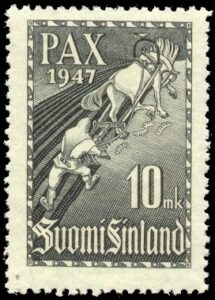
The accords forced Finland to make a number of adjustments:
- It was restored to its original territory, dated January 1941, as it was compelled to change its border following the Winter War of 1939-1940. However, it needed to hand over the Petsamo area to the Soviet Union which is located in the country's far north.
- It was compelled to pay $300,000,000 in reparations to the Soviet Union.
- It was compelled to scale back its armed forces and place restrictions on the number of military equipment it could own.
- It had to proclaim that it would not take sides in future confrontations.
Hungary
Hungary was forced to make a number of compromises as a result of the treaties, including the following:
- It was restored to its original territory dated January 1941. However, it lost a sizable portion of its land to its neighbours, including portions of Transylvania that were given to Romania.
- It was ordered to pay the Soviet Union $200,000,000 in reparations and $100,000,000 to Czechoslovakia and Yugoslavia.
- A democratic government had to be put in place, and free and fair elections had to be held.
- It was compelled to set caps on the size of its armed forces as well as on the kinds of tools and weapons it might own.
Romania
The accords forced Romania to make a number of adjustments, including the following:
- It was restored to its original territory dated January 1941. Although it lost some of Transylvania to Hungary and the Soviet Union, it also gained substantial territory from Bulgaria and Hungary.
- It was compelled to pay $300,000,000 in reparations to the Soviet Union.
- A democratic government had to be put in place, and free and fair elections had to be held.
- It was compelled to set caps on the size of its armed forces as well as on the kinds of tools and weapons it might own.
Generally speaking, the Paris Peace Treaties of 1947 signalled the conclusion of World War II and defined the terms of peace between the victorious Allies and the Axis powers. Additionally, they prepared the groundwork for the reconstruction of post-war Europe and the creation of a new international order. Some contended, however, that the treaties exacerbated the economic difficulties of the vanquished states and did not address underlying problems like nationalism and territorial disputes, which led to further hostilities.
Other Agreements: Yalta and Potsdam Conferences; The 1951 Treaty of San Francisco
As for Germany and Japan, other conferences were held to be able to determine the changes which had to be made following the aftermath of the Second World War.
Yalta and Potsdam Conferences
- Between 4 and 11 February 1945, a meeting occurred between the heads of the government of the United Kingdom, the United States, and the Soviet Union. Commonly referred to as the ‘Big Three’, Prime Minister Winston Churchill, President Franklin D. Roosevelt, and Premier Joseph Stalin congregated near Yalta in Crimea.
KEY POINTS DISCUSSED IN THE YALTA CONFERENCE:
- Roosevelt wanted to assure their victory against Japan. He sought military assistance from Stalin in exchange for Sakhalin and the Kuril Islands, as well as railroad rights in Manchuria and two water ports.
- The creation of the United Nations with the cooperation of the Big Three.
- Unconditional surrender of Germany with $20 billion in reparations.
- Germany would be divided into four occupation zones.
- A free election in Eastern Europe such as in the case of Poland.
Between 17 July and 2 August 1945, the heads of the government of the United Kingdom, the United States, and the Soviet Union convened in Potsdam, Germany.
On May 1945, Germany completely surrendered. Prior to this, Roosevelt died on 12 April and was replaced by Harry Truman. Moreover, Churchill lost the 1945 election and was replaced by Clement Attlee. Hence, the two represented the United Kingdom at the conference.
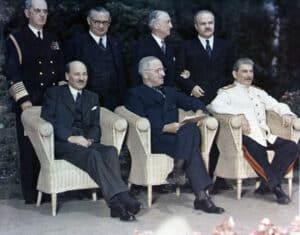
OUTCOMES
YALTA
- Germany would be divided into four zones occupied by the USSR, Britain, France and the USA.
- Though Germany’s capital, Berlin, was inside the Soviet zone, it too was to be divided into four zones controlled by one of the Allied powers.
- All countries freed from Nazi control were assured the right to free, democratic elections. However, Stalin’s spheres of influence were dominated by communism.
- Stalin committed to joining the war against Japan. All leaders committed to pursuing Nazi war criminals and setting up the United Nations.
POTSDAM
- Stalin showed no sign of allowing free elections in Eastern Europe and a communist government was being set up in Poland.
- Arguments were had over where the boundaries between the zones would be drawn.
- Conflict over how much the USSR could take in reparations, i.e. whatever they needed from Soviet-controlled zones and 10% from Western zones.
- Allies were concerned that reparations were repeating the mistakes of the Treaty of
Versailles after World War One.
Treaty of San Francisco
- On 8 September 1951, Japan and the Allies signed the Treaty of San Francisco, periodically referred to as the Treaty of Peace with Japan. It formally put an end to Japan's participation in World War II and restored its independence.
- The treaty compelled Japan to give up any claims to lands it had seized by invasion, such as Korea and Taiwan, and to accept the occupation of a number of regions, like Okinawa, by the Allied powers. In addition, Japan had to reduce its military capability and submit to the Allied countries' control over its military defence. Although the conditions of the reparations were later changed, Japan agreed to pay war reparations to the Allies.
- Overall, the Treaty of San Francisco was a significant accord that laid the groundwork for peace and security in East Asia and shaped the post-war world order.

